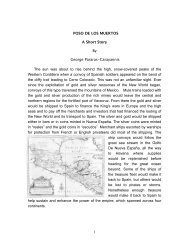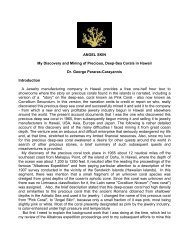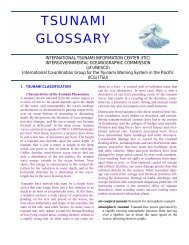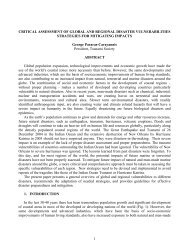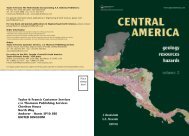A Study of the Source Mechanism of the Alaska Earthquake and ...
A Study of the Source Mechanism of the Alaska Earthquake and ...
A Study of the Source Mechanism of the Alaska Earthquake and ...
Create successful ePaper yourself
Turn your PDF publications into a flip-book with our unique Google optimized e-Paper software.
304limit to extend to <strong>the</strong> west side <strong>of</strong> Shelik<strong>of</strong>Strait <strong>and</strong> Cook Inlet.In estimating <strong>the</strong> travel time <strong>of</strong> <strong>the</strong> tsunami,corrections were made for <strong>the</strong> delay at <strong>the</strong> isl<strong>and</strong><strong>of</strong> Kodiak in <strong>the</strong> arrival <strong>of</strong> <strong>the</strong> groundshocks from Prince William Sound. These correctionsranged from 1 minute to 6 minutes <strong>and</strong>were based on <strong>the</strong> fact that <strong>the</strong> Navy W ea<strong>the</strong>rCentr al on <strong>the</strong> isl<strong>and</strong> <strong>of</strong> Kodiak listed <strong>the</strong> time<strong>of</strong> <strong>the</strong> principal shock in Prince W illiam Soundas 6 minutes later than <strong>the</strong> time listed by <strong>the</strong>U. S. Coast <strong>and</strong> Geodetic Survey. This wouldimply that <strong>the</strong> wave front generated on <strong>the</strong>nor<strong>the</strong>ast side <strong>of</strong> <strong>the</strong> disturbance area had a 6minute head start on <strong>the</strong> wave front generatedsou<strong>the</strong>ast <strong>of</strong> Kodiak.The tsunami-generating area covers an area700 km long by 150 km wide, a total <strong>of</strong> about105,000 krn-, The volume <strong>of</strong> <strong>the</strong> uplifted crustalong <strong>the</strong> continental shelf is about 96 krn". Theenergy associated with <strong>the</strong> tsunami has beenestimated by Van Dorn ( 1964) to be <strong>of</strong> <strong>the</strong>order <strong>of</strong> 2.3 X 10 21 ergs. This estimate is basedon <strong>the</strong> source dimensions <strong>of</strong> an area 240 nauticalmiles by 100 nautical miles <strong>and</strong> an uplift<strong>of</strong> 1.8 m ( 6 ft ) at <strong>the</strong> nor<strong>the</strong>astern end <strong>of</strong> thisarea <strong>and</strong> zero at <strong>the</strong> southwestern end. Thisestimate, however, is considered low because <strong>the</strong>generating area had dimensions that were largerthan those estimated by Van Dorn.Using our source dimensions, <strong>and</strong> assumingthat <strong>the</strong> total energy was equal to <strong>the</strong> potent ialenergy <strong>of</strong> <strong>the</strong> uplifted volume <strong>of</strong> water, <strong>the</strong>total energy for <strong>the</strong> tsunami in <strong>the</strong> Gu lf <strong>of</strong><strong>Alaska</strong> was calculated as follows:1E t = - pgh 2 A61= - (1.03) ( .980) (1 0 3 ) (10 4 ) ( 1.8 3 2 ) (1.56X 10 7 ) (7 X 10 7 ) = 5.88 X 10 21 ergswhereE, = E" = total energyp = 1.03 g/cm 3 = densityg = 980 cm/sec 2h = height <strong>of</strong> displacement = 1.83 mA = area1 erg = g cm 2 sec- 2The waves generated in <strong>the</strong> Gulf <strong>of</strong> <strong>Alaska</strong>were <strong>of</strong> an unusually long period, on <strong>the</strong> orderPACIFIC SCIENCE, Vol. XXI, July 1967<strong>of</strong> an hour or more:' Th eir energy radiation waspreferentially directed toward <strong>the</strong> sou<strong>the</strong>ast <strong>and</strong>this is why more damage was done to <strong>the</strong> N orthAmerican coast than anywhere else east or south<strong>of</strong> <strong>the</strong> generating area. This preferential directivity<strong>of</strong> energy radiation can be attributed to<strong>the</strong> orientation <strong>of</strong> <strong>the</strong> tectonic displacementsalong <strong>the</strong> continental shelf <strong>of</strong> <strong>the</strong> Gulf <strong>of</strong><strong>Alaska</strong>, <strong>and</strong> <strong>the</strong> long period <strong>of</strong> <strong>the</strong> waves canbe related to <strong>the</strong> long seiche period <strong>of</strong> <strong>the</strong>shallow shelf.According to Japanese seismologists (Iida,1958), <strong>the</strong> generating area <strong>of</strong> a tsunami roughlycorresponds to <strong>the</strong> distribution <strong>of</strong> <strong>the</strong> majoraftershocks. This appears to be indeed <strong>the</strong> casein <strong>the</strong> Gulf <strong>of</strong> <strong>Alaska</strong>.There were 52 aftershocks <strong>of</strong> <strong>the</strong> <strong>Alaska</strong>earthquake. The largest had a magnitud e <strong>of</strong> 6.7.The aftershocks occurred in an area from about15 km north <strong>of</strong> Vald ez to about 55 km south <strong>of</strong>Trinity Isl<strong>and</strong>s, <strong>and</strong> were heavily concentratedon <strong>the</strong> nor<strong>the</strong>ast <strong>and</strong> <strong>the</strong> southwest <strong>of</strong> <strong>the</strong> upliftedregion (USCGS, 1964), which also was<strong>the</strong> main tsunami-generating area.The vast area <strong>of</strong> tectonic movements indicatesthat wave crests were generated along one ormore line sources from <strong>the</strong> region <strong>of</strong> maximumupli ft. Thus, <strong>the</strong> shores <strong>of</strong> <strong>the</strong> Kenai Penin sulawere struck within 20 minutes after <strong>the</strong> start <strong>of</strong><strong>the</strong> earthquake, <strong>and</strong> those <strong>of</strong> Kodiak Isl<strong>and</strong> ,within 34 minutes.Unfortun ately, <strong>the</strong> violence <strong>of</strong> <strong>the</strong> earthquakeleft south-cent ral <strong>Alaska</strong> without a tide gaugein operation. The only reliable record from <strong>the</strong>generating area is <strong>the</strong> one that was obtained bypersonnel <strong>of</strong> <strong>the</strong> U. S. N avy Fleet W ea<strong>the</strong>rStation at Kodiak; it is shown in Figure 2. Thisrecord has been corrected for <strong>the</strong> 1.7-m (5 .6-ft)submergence <strong>of</strong> <strong>the</strong> area.Outside <strong>the</strong> immediate generating area, <strong>the</strong>record <strong>of</strong> Cape Yakataga, as constructed from<strong>the</strong> personal account <strong>of</strong> C. R. Bilderback, a resident<strong>of</strong> <strong>the</strong> area, is <strong>the</strong> next most reliable record.This record is <strong>the</strong> only one obtained outside<strong>the</strong> generating area that shows an initial dropin <strong>the</strong> water level (Berg et aI., in preparation ) .Withdrawal <strong>of</strong> <strong>the</strong> water immediately following<strong>the</strong> earthquake has been reported from Kayak,Middl eton, <strong>and</strong> Hinchinbrook isl<strong>and</strong>s, as wellas from Rocky Bay <strong>and</strong> N uka Bay, at <strong>the</strong> end



